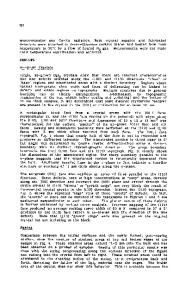Crystal growth and structure analysis of Sm 2-x Ce x CuO 4
- PDF / 339,908 Bytes
- 6 Pages / 612 x 792 pts (letter) Page_size
- 44 Downloads / 303 Views
M. Okuno Department of Earth Sciences, Kanazawa University, Kanazawa 920-1192, Japan
M. Ohgaki and K. Yamashita Institute of Biomaterials and Bioengineering, Tokyo Medical and Dental University, Tokyo 101-0062, Japan
T. Matsumoto Department of Earth Sciences, Kanazawa University, Kanazawa 920-1192, Japan (Received 10 March 2000; accepted 15 June 2000)
The phase diagram of the Sm2O3–CuO system was investigated by the combination of the differential thermal analysis and the quench method. The results showed that Sm2CuO4 incongruently melts at about 1220 °C, and that the solid Sm2CuO4 exists in equilibrium with the liquid consisting of 81–95 mol% CuO in the range of 1060–1220 °C. On the basis of the phase diagram, Sm2−xCexCuO4 single crystals were grown by the traveling solvent floating zone method. The crystal structure [space group I4/mmm, a ⳱ 3.917(1), c ⳱ 11.899(2) Å] has been refined using single-crystal x-ray diffraction data with a precision corresponding to an R index of 0.02.
I. INTRODUCTION
The titled substance, Sm2−xCexCuO4(x ⳱ 0.15), is one of the electron-doped oxide superconductors Ln2−xCexCuO4 (Ln ⳱ Nd, Pr, Sm) that have been reported on in Ref. 1. The physical and chemical properties of Nd2−xCexCuO4, which has the highest superconducting transition temperature (Tc ⳱ 24K) of these type compounds, has been extensively investigated.2–6 Physical (magnetic, transport, electric, etc.) properties of the Sm2−xCexCuO4 polycrystals7,8 and single crystals9,10 have been recently described. Growing large crystals Nd 2 − x Ce x CuO 4 and Pr2−xCexCuO4 based on the flux or traveling-solvent floating zone (TSFZ) methods have been widely reported.117–14 However, there are presently few descriptions about the crystal growth of Sm2−xCexCuO4.15 It has been reported that the presence of vacancies at the two oxygen sites is noteworthy in connection with the understanding of the superconductivity mechanism in Ln2−xCexCuO4 (Ln ⳱ Nd, Pr, Sm).16,17 The determination of the oxygen deficiency in Nd2−xCexCuO4 and
a)
Address all correspondence to this author. Present address: Graduate School of Material Science, Nara Institute of Science and Technology, 8916-5 Takayama, Ikoma, Nara 630-0101, Japan. e-mail: [email protected] J. Mater. Res., Vol. 15, No. 9, Sep 2000
Pr2−xCexCuO4 has been carried out by x-ray, neutron, and electron diffraction techniques.18–23 Structure refinements of Ln2−xCexCuO4 using x-ray diffraction (XRD) techniques are effective means to provide important information on the role of strongly correlated electrons in superconductivity. The electron-density distribution of only Nd2−xCexCuO4−␦ crystal has been reported.23 In this report, we describe the phase diagram of the Sm2O3–CuO system determined by differential thermal analysis (DTA) and the quenching method. Subsequently, the crystal growth of Sm2−xCexCuO4 by the TSFZ method will be reported. Moreover, the structural features of the crystal analyzed by XRD techniques will be described. II. EXPERIMENTAL A. Phase diagram of the Sm2O3–CuO system
The
Data Loading...











